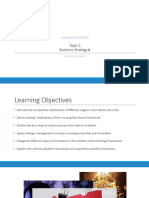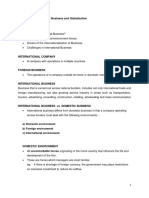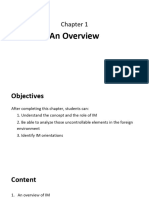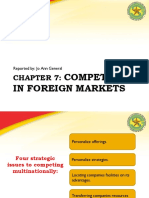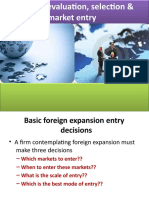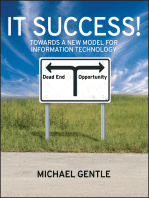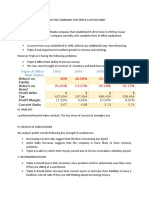0 ratings0% found this document useful (0 votes)
32 viewsUse of Assets Challenges Global Business
Use of Assets Challenges Global Business
Uploaded by
Aby MathewThe document discusses various challenges and opportunities related to global business, including currency exchange rates, taxation systems, and cultural differences. It also covers strategies for global marketing such as standardization versus adaptation and integration forces like technology, culture, and market needs that drive global marketing. International strategic management is discussed, including different types of strategies like competitive advantage, cost advantage, and market dominance. Benefits of strategic planning include coordinating operations and managing political and competitive risks, though costs can include potential micromanagement of subsidiaries. A home replication strategy utilizes core competencies developed domestically as the main competitive advantage internationally.
Copyright:
Attribution Non-Commercial (BY-NC)
Available Formats
Download as PPTX, PDF, TXT or read online from Scribd
Use of Assets Challenges Global Business
Use of Assets Challenges Global Business
Uploaded by
Aby Mathew0 ratings0% found this document useful (0 votes)
32 views6 pagesThe document discusses various challenges and opportunities related to global business, including currency exchange rates, taxation systems, and cultural differences. It also covers strategies for global marketing such as standardization versus adaptation and integration forces like technology, culture, and market needs that drive global marketing. International strategic management is discussed, including different types of strategies like competitive advantage, cost advantage, and market dominance. Benefits of strategic planning include coordinating operations and managing political and competitive risks, though costs can include potential micromanagement of subsidiaries. A home replication strategy utilizes core competencies developed domestically as the main competitive advantage internationally.
Original Title
sahry
Copyright
© Attribution Non-Commercial (BY-NC)
Available Formats
PPTX, PDF, TXT or read online from Scribd
Share this document
Did you find this document useful?
Is this content inappropriate?
The document discusses various challenges and opportunities related to global business, including currency exchange rates, taxation systems, and cultural differences. It also covers strategies for global marketing such as standardization versus adaptation and integration forces like technology, culture, and market needs that drive global marketing. International strategic management is discussed, including different types of strategies like competitive advantage, cost advantage, and market dominance. Benefits of strategic planning include coordinating operations and managing political and competitive risks, though costs can include potential micromanagement of subsidiaries. A home replication strategy utilizes core competencies developed domestically as the main competitive advantage internationally.
Copyright:
Attribution Non-Commercial (BY-NC)
Available Formats
Download as PPTX, PDF, TXT or read online from Scribd
Download as pptx, pdf, or txt
0 ratings0% found this document useful (0 votes)
32 views6 pagesUse of Assets Challenges Global Business
Use of Assets Challenges Global Business
Uploaded by
Aby MathewThe document discusses various challenges and opportunities related to global business, including currency exchange rates, taxation systems, and cultural differences. It also covers strategies for global marketing such as standardization versus adaptation and integration forces like technology, culture, and market needs that drive global marketing. International strategic management is discussed, including different types of strategies like competitive advantage, cost advantage, and market dominance. Benefits of strategic planning include coordinating operations and managing political and competitive risks, though costs can include potential micromanagement of subsidiaries. A home replication strategy utilizes core competencies developed domestically as the main competitive advantage internationally.
Copyright:
Attribution Non-Commercial (BY-NC)
Available Formats
Download as PPTX, PDF, TXT or read online from Scribd
Download as pptx, pdf, or txt
You are on page 1of 6
challenges Use of assets
Currency Global business
Interest rates Licensing of intellectual property
Taxation systems Royalty
Government regulations Patents
Language Trademarks
Culture Technology
Uncertainties Export of intangibles
• FDI-ADVANTAGES
LICENSING -ADVANTAGES • Locals partner knows the domestic
• Less risk business environments better
• No investment needed • Easy management
• Assured returns • Easy access to local market
• Less uncertainty –local licensee • Good image for both
• Less fear of govt. controls • Can abide by local rules and regulations
• Good for host country • RISK
• Local partner’s interference
LICENSING- DIS ADVANTAGES
• Quality cannot be assured • Difficulty to ensure quality
• Nurturing a competitor abroad • Supremacy of local partner
• Reduced opportunity to enter and • Repatriation limitations
establish business
• Technology sharing
• Technology theft
Global Marketing Adaptation
• Identifying goods and services that Differences in technical standards
customers outside the home country want Consumer and personal use product
Variations in consumer needs
• Provide these at the right time and place
Variations in conditions of use
Marketing for different type of Consumer and Variations in abilities to buy
Product Independent national subsidiaries
• Consumer marketing -Supplying Cultural impact
consumers generally with branded Government influence
products Export Pricing policies
• Industrial marketing -Supplying a) Cost-Plus Pricing: adds international costs
differentiated ingredients to processors and a mark-up to the domestic manufacturing
and manufacturers cost.
b) Dynamic Incremental Pricing: only variable
• Commodity marketing -Supplying costs and a portion of the overhead load
undifferentiated raw materials (incremental costs) should be recuperated.
Standardization • Exporting-related incremental costs
High cost of adaptation (manufacturing costs, shipping expenses,
insurance, and overseas promotional costs).
• Industrial products
GLOBAL MARKETING
• Convergence and similar tastes in divergent • Denotes the use of advertising and marketing on
• markets a global basis.
• Predominant use in urban environments • Marketing is at the threshold of a new and
• Marketing to predominantly similar exciting era: e-business, e-commerce and e-
marketing
countries
• Business has two basic functions: marketing and
• Centralised management and operations innovation (Drucker)
• Country-of-origin effect • New era of competition, demanding customers
• Economies of scale • More stakeholders (customers, employees,
media).
GLOBAL MARKETING-INTEGRATION
FORCES
Driving Forces Challenges
Technology • Markets can present higher profit opportunities than present
Culture markets.
• Markets can offer size but not profits.
Market Needs
• Company needs a larger customer base for economies of scale.
Costs
• Present customers are needing service and products as they go
Free Markets international.
Economic Integration DUMPING
Peace • WTO: Sale of an imported product at ‘less than fair value’ and
Strategic Intent causes ‘material injury to a domestic industry’.
Management Vision, • US: An unfair trade practice that results in injury, destruction, or
Strategy and Action the prevention of the establishment of an American industry.
Restraining Forces • US considers dumping when price is >5% below home market
price or,
Culture
• Price is below cost of production
Market Differences
Costs • 4P’S
National Controls • Place (distribution)
• Transportation to international freight carrier
Nationalism
Freight,
Peace vs. War/ Stability Insurance,
Management Myopia Documentation,
Organization History Customs clearance,
Domestic Focus Local transportation,
Logistic management “in the market”,
Currency risk
Product – usually controlled by the exporter, initially the least
impacted element of the marketing mix
• “localization” often required
• approvals and certificates
• packaging & labeling
• measures, etc
Promotion – success at home leads to interest from
potential importers, licensors, joint venture partners
International strategic management Types of Strategy
• Competitive Advantage – something which gives the
A comprehensive and ongoing management organisation some advantage over its rivals
planning process aimed at formulating and • Cost advantage – A strategy to seek out and secure a cost
implementing strategies that enable a firm to advantage
compete effectively internationally. of some kind - lower average costs, lower labour costs, etc.
Strategic goals • Market Dominance- Achieved through:
• Strategic goals are the major objectives the – Internal growth
firm wants to accomplish through pursuing a – Acquisitions – mergers and takeovers
particular course of action. • New product development: to keep ahead of rivals and set
• they should be measurable, the pace
• feasible, • Contraction/Expansion – focus on what you are good at
• time-limited, (core competencies) or seek to expand into a range of
• Five-Forces (developed by Michael Porter) markets?
• forces that shape and influence the industry • Price Leadership – through dominating the industry –
or market the organisation operates in. others follow your price lead
• Global – seeking to expand global operations
1.Strength of Barriers to Entry - how easy is
it for new rivals to enter the industry? • Reengineering – thinking outside the box – looking at news
ways of doing things to leverage the organisation’s
2.Extent of rivalry between firms – how performance
competitive is the existing market?
• Downsizing – selling off unwanted parts of the business –
3.Supplier power – the greater the power, similar to contraction
the less control the organisation has on • Delayering – flattening the management structure,
the supply of its inputs. removing bureaucracy, speed up decision making
4.Buyer power – how much power do • Restructuring – complete re-think
customers in the industry have? of the way the business is organised
5.Threat from substitutes – what alternative
products and services are there and
what is the extent of the threat they
Home Replication Strategy
Perceived Benefits of Strategic Planning
– Coordinate and monitor operations
• a firm utilizes the core competency or firm- – Streamline product lines and supply chains
specific advantage it developed at home as its – Manage political, currency, and competitive risks
main competitive weapon in the foreign markets – Potential costs
Micromanagement of subsidiary operations
that it enters. – Misallocation of time and staff resources
• it takes what it does exceptionally well in its – Over-planning and lower profitability
home market and attempts to duplicate it in
foreign markets.
• Multidomestic strategy :
• Main aim is maximum local responsiveness • Global Integration
• Products and services homogeneous in terms of type and quality
• Customize product offering, market strategy • Customers have common taste preferences
including production, and R&D according to • National Responsiveness
national conditions • Segmented regional markets
• Generally unable to realize value from • Need to respond to differing national standards and regulations
experience curve effects and location economies • Adaptation of tools and techniques to manage local workforces
• Possess high cost structure
• Transnational strategy • Pyramid” Strategies
• To meet competition firms aim to reduce costs, Engage in significant international activity a short time after being
transfer core competencies while paying established
attention to pressures for local responsiveness • Successful firms leverage a distinctive mix of orientations and
• Global learning strategies
– Valuable skills can develop in any of the • Global technological competence
firm’s world wide operations • Unique-products development
– Transfer of knowledge from foreign • Quality focus
subsidiary to home country, to other • Leveraging of foreign distributor competences
foreign subsidiaries • Targeting emerging market
• Transnational strategy difficult task due to • Marketing requires smaller-scale strategies
contradictory demands placed on the • Building relationships with local governments, small entrepreneurs,
organization and nonprofits
• Less dependence on central governments and large local
companies
Pyramid” Strategies
You might also like
- Case Studies On Market Entry Strategies - Vol. IDocument9 pagesCase Studies On Market Entry Strategies - Vol. Iibscdc0% (1)
- Introduction To International MarketingDocument53 pagesIntroduction To International Marketingshailu100% (1)
- INBTDocument15 pagesINBTJoferlyn Mai Marabillo VillarNo ratings yet
- Slides Chapter 6 - International StrategyDocument17 pagesSlides Chapter 6 - International Strategyjackie richardsonNo ratings yet
- Session 1 and 2 SlidesDocument61 pagesSession 1 and 2 SlidesNeluka vishuddhiNo ratings yet
- International StrategyDocument17 pagesInternational Strategyzobia.zobia110No ratings yet
- Bafin CH01Document5 pagesBafin CH01Sharilyn CasisimanNo ratings yet
- Marketing Strategy Session 4 - Pricing PDFDocument22 pagesMarketing Strategy Session 4 - Pricing PDFSSNo ratings yet
- Inbt211 ReviewerDocument13 pagesInbt211 ReviewerSydney Miles MahinayNo ratings yet
- Lesson 9 - International StrategyDocument37 pagesLesson 9 - International StrategysurangauorNo ratings yet
- International StrategyDocument26 pagesInternational StrategyQuân Đoàn MinhNo ratings yet
- Paper 1 Topic OutlineDocument46 pagesPaper 1 Topic OutlineneishamaraNo ratings yet
- WEEK 9 International StrategiesDocument28 pagesWEEK 9 International StrategiesNella RodriguezNo ratings yet
- Ihrm Sustaining International Business OperationsDocument47 pagesIhrm Sustaining International Business OperationsRabbir Rashedin TirnoNo ratings yet
- BS4 International Business Entry ModesDocument34 pagesBS4 International Business Entry ModesdoctshNo ratings yet
- Strategy Analysis: Analysing Organizational Goals and ObjectivesDocument13 pagesStrategy Analysis: Analysing Organizational Goals and ObjectivesmarNo ratings yet
- Initiation of InternationalizationDocument28 pagesInitiation of Internationalization63shripriuNo ratings yet
- Lect 4 Forms of International Business ActivitiesDocument42 pagesLect 4 Forms of International Business ActivitiesTrần HuyNo ratings yet
- Strategies To Enter Foreign MarketsDocument29 pagesStrategies To Enter Foreign MarketsRitika MantriNo ratings yet
- Topic 5Document56 pagesTopic 5dhyukm7No ratings yet
- Global Marketing Chapter 1-2Document36 pagesGlobal Marketing Chapter 1-2Iyus Darmawan PYNo ratings yet
- Session 9 International Strategy New - 6377790b17033Document66 pagesSession 9 International Strategy New - 6377790b17033champika de alwisNo ratings yet
- GlobalmarketingDocument15 pagesGlobalmarketingTeesha shahNo ratings yet
- International Business FunctionsDocument56 pagesInternational Business FunctionsGaurav SinghNo ratings yet
- Global Business Management Write-Up Assignment 4Document6 pagesGlobal Business Management Write-Up Assignment 4徐筱晴No ratings yet
- The Strategy of International BusinessDocument27 pagesThe Strategy of International BusinessGaurav SinghNo ratings yet
- 2024 Global Marketing RevisionDocument135 pages2024 Global Marketing RevisionLorena UchôaNo ratings yet
- SM 22 S15 Virgin & Global StrategiesDocument12 pagesSM 22 S15 Virgin & Global StrategiesAditya SinhaNo ratings yet
- Session EntryDocument20 pagesSession Entrybadboy99.tkNo ratings yet
- Becore LSSN 7-8Document4 pagesBecore LSSN 7-8Chiel Sea Erica CutchonNo ratings yet
- International Business Environment Bafin c4Document3 pagesInternational Business Environment Bafin c4Jorim TamayoNo ratings yet
- Strategies For International Competition - GlobalOperationsDocument37 pagesStrategies For International Competition - GlobalOperationsDeepa ChandirrasekarNo ratings yet
- Ibt Reviewer 2 PDFDocument20 pagesIbt Reviewer 2 PDFSanji AmbrosioNo ratings yet
- 8 International+StrategyDocument28 pages8 International+StrategyRizeNo ratings yet
- Chapter 21 - GloblizationDocument39 pagesChapter 21 - GloblizationAhmed WahidNo ratings yet
- Globalization - International Processing StrategyDocument23 pagesGlobalization - International Processing StrategyAnand MauryaNo ratings yet
- Global Marketing PDFDocument13 pagesGlobal Marketing PDFMaksumul MorsalineNo ratings yet
- IMM Merged SlidesDocument287 pagesIMM Merged SlidesMukul GuptaNo ratings yet
- CH 08 International and Global Product StrategyDocument51 pagesCH 08 International and Global Product Strategywelcome2jungleNo ratings yet
- International StrategyDocument33 pagesInternational StrategyGohar SaeedNo ratings yet
- Aspects of International/Global MarketingDocument22 pagesAspects of International/Global MarketingPulkit ShowNo ratings yet
- International BusinessDocument19 pagesInternational BusinessSyana SamsudenNo ratings yet
- Skill Based Subject Fundmantals of Foreign Trade and DocumentationDocument36 pagesSkill Based Subject Fundmantals of Foreign Trade and DocumentationprakashputtuNo ratings yet
- International StrategyDocument32 pagesInternational Strategyrishupahuja90No ratings yet
- International Marketing C1Document24 pagesInternational Marketing C1phiht224022cNo ratings yet
- L5 - International Business StrategyDocument33 pagesL5 - International Business Strategyst.vinod2711No ratings yet
- Tarptautinės Rinkodaros Strategijos - Rūšys, Pasirinkimo Motyvai Bei TaikymasDocument37 pagesTarptautinės Rinkodaros Strategijos - Rūšys, Pasirinkimo Motyvai Bei TaikymasDomas GreičiūnasNo ratings yet
- C5Document34 pagesC5rhryhdk5h8No ratings yet
- Competing in Foreign MarketsDocument36 pagesCompeting in Foreign MarketsJo AnnNo ratings yet
- Internationaliztion AqaDocument18 pagesInternationaliztion AqaYIDAN WangNo ratings yet
- International Strategy BuspolDocument22 pagesInternational Strategy BuspolSarah PableoNo ratings yet
- INTERNATIONAL TRADEDocument20 pagesINTERNATIONAL TRADEMike James Rudio AgnesNo ratings yet
- International Markets Entry StrategiesDocument58 pagesInternational Markets Entry StrategiesTania GhoshNo ratings yet
- Today's Objectives: - Competing InternationallyDocument16 pagesToday's Objectives: - Competing InternationallyCool Leong LamNo ratings yet
- Unit-1 IM PDFDocument121 pagesUnit-1 IM PDFnitesh kumarNo ratings yet
- Foreign Market Entry StrategiesDocument48 pagesForeign Market Entry StrategiesHeta SanghaniNo ratings yet
- LESSON 2 - Globalisation Internalisation of Diff. Industries MarketsDocument22 pagesLESSON 2 - Globalisation Internalisation of Diff. Industries MarketsRumeysha rujubNo ratings yet
- 7.global MarketingDocument30 pages7.global MarketingChirag GoyalNo ratings yet
- IT Success!: Towards a New Model for Information TechnologyFrom EverandIT Success!: Towards a New Model for Information TechnologyRating: 3 out of 5 stars3/5 (1)
- Smooth Sailing: A Quick Guide to Effective Cargo Import and Export: Logistics, #1From EverandSmooth Sailing: A Quick Guide to Effective Cargo Import and Export: Logistics, #1No ratings yet
- Application For Final Marksheet and Diploma / Degree: Personal RecordDocument2 pagesApplication For Final Marksheet and Diploma / Degree: Personal RecordAby MathewNo ratings yet
- The United Nations: Youth Advocate Program International 4546 42 St. NW, Suite 209 Washington DC, 10016, USADocument16 pagesThe United Nations: Youth Advocate Program International 4546 42 St. NW, Suite 209 Washington DC, 10016, USAAby MathewNo ratings yet
- 882 Re-Engineered: Offering The Best in The IndustryDocument5 pages882 Re-Engineered: Offering The Best in The IndustryAby MathewNo ratings yet
- 2 Spare PIDocument1 page2 Spare PIAby MathewNo ratings yet
- Plantationa ActDocument4 pagesPlantationa ActAby MathewNo ratings yet
- Universal Declaration of Human RightsDocument16 pagesUniversal Declaration of Human RightsAby MathewNo ratings yet
- HR Case StudyDocument50 pagesHR Case Studyrakeshnandiymail50% (4)
- Photo: GraphyDocument99 pagesPhoto: GraphyAby Mathew100% (1)
- Ak Agarwal: by Aby MathewDocument7 pagesAk Agarwal: by Aby MathewAby MathewNo ratings yet
- Women Entrepreneurs: Shahnaz Husain Kiran Mazumdar Shah Ekta KapoorDocument13 pagesWomen Entrepreneurs: Shahnaz Husain Kiran Mazumdar Shah Ekta KapoorKarthi KeyanNo ratings yet
- Airtel October 2024Document2 pagesAirtel October 2024djbalu5No ratings yet
- Vii-Adjusting Entries DepreciationDocument3 pagesVii-Adjusting Entries DepreciationHassanhor Guro BacolodNo ratings yet
- OPEC MOMR June 2024Document92 pagesOPEC MOMR June 2024violeta chen cajbonNo ratings yet
- Math BisayDocument39 pagesMath BisayROOOOHEENNo ratings yet
- An Understanding of TATA-JLR Deal With The Concepts of Downsizing, Corporate Culture and Leveraged BuyoutDocument4 pagesAn Understanding of TATA-JLR Deal With The Concepts of Downsizing, Corporate Culture and Leveraged BuyoutKaranNo ratings yet
- Exam QuestionsDocument4 pagesExam QuestionsKenanNo ratings yet
- Scan Sep 17, 2022Document1 pageScan Sep 17, 2022zunijemNo ratings yet
- Si No Task ListDocument6 pagesSi No Task ListHari Hara SuthanNo ratings yet
- BANK NIFTY WEEKLY OPTIONS - 11 PRACTICAL TRADING SETIFFERENT MARKET CONDITIONS - Prathyush P GopinathanDocument93 pagesBANK NIFTY WEEKLY OPTIONS - 11 PRACTICAL TRADING SETIFFERENT MARKET CONDITIONS - Prathyush P Gopinathanwadatkar.amit104No ratings yet
- Ratio Solved ProblemDocument6 pagesRatio Solved Problemhohrmpm2No ratings yet
- Supply Chain Final ExamDocument2 pagesSupply Chain Final ExamJohn bernard CortesNo ratings yet
- Odoo Overview en v1.0Document9 pagesOdoo Overview en v1.0europass203No ratings yet
- Introduction To Human Resource Management: Mission Vision Core ValuesDocument36 pagesIntroduction To Human Resource Management: Mission Vision Core ValuesRohit GoyalNo ratings yet
- AMR PaperDocument21 pagesAMR PaperNauman AsgharNo ratings yet
- Additions To TaxDocument22 pagesAdditions To Taxstannis69420No ratings yet
- Vol18Sabah Section2Document38 pagesVol18Sabah Section2Naziemi AhmadNo ratings yet
- Grade 12 BankingDocument2 pagesGrade 12 Bankings.abdulrehman2020No ratings yet
- 1.04 What Gives The Dollar Bill Its Value Answer Key-1Document2 pages1.04 What Gives The Dollar Bill Its Value Answer Key-1Eboni KingNo ratings yet
- Ch11 Panel PA Feb2021Document27 pagesCh11 Panel PA Feb2021Phuc Hong PhamNo ratings yet
- Triple A Final Analysis Rangel Maribel, DisscussionDocument7 pagesTriple A Final Analysis Rangel Maribel, DisscussionZahid UsmanNo ratings yet
- Canons of TaxationDocument6 pagesCanons of TaxationAanchal Singhal100% (3)
- University of Tunis Tunis Business SchoolDocument2 pagesUniversity of Tunis Tunis Business Schoolmolka ben mahmoudNo ratings yet
- 12th Accountancy EM Important Questions English Medium PDF DownloadDocument4 pages12th Accountancy EM Important Questions English Medium PDF Downloadqueensmiling495100% (1)
- Strategic Management: Assignment IiDocument3 pagesStrategic Management: Assignment IiVishnu Priyan LNo ratings yet
- DUpont Case SummaryDocument4 pagesDUpont Case Summaryabhishekhrc0% (1)
- AC 3 - Intermediate Acctg' 1 (Ate Jan Ver)Document119 pagesAC 3 - Intermediate Acctg' 1 (Ate Jan Ver)John Renier Bernardo100% (1)
- Account StatementDocument8 pagesAccount Statement236ksfeNo ratings yet
- Peer Analysis of Major Players in Cement Industry: ACC, Ambuja, Dalmia, Shree, UltratechDocument6 pagesPeer Analysis of Major Players in Cement Industry: ACC, Ambuja, Dalmia, Shree, Ultratechsai chandraNo ratings yet
- Inb 372 Chapter 1Document24 pagesInb 372 Chapter 1Jawadul IslamNo ratings yet



















